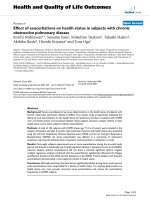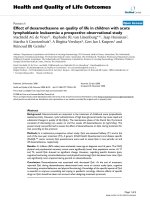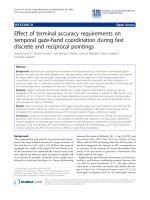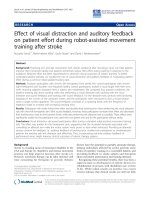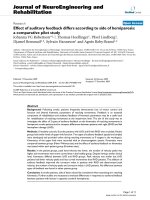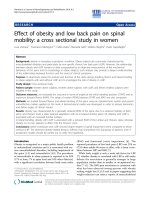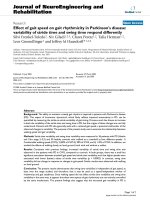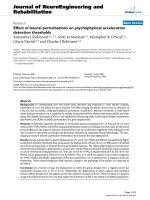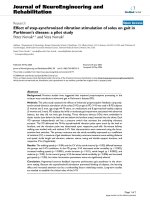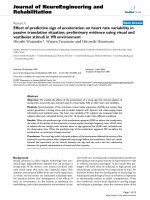báo cáo hóa học: " Effect of optical flow versus attentional strategy on gait in Parkinson''''s Disease: a study with a portable optical stimulating device" pptx
Bạn đang xem bản rút gọn của tài liệu. Xem và tải ngay bản đầy đủ của tài liệu tại đây (418.78 KB, 9 trang )
BioMed Central
Page 1 of 9
(page number not for citation purposes)
Journal of NeuroEngineering and
Rehabilitation
Open Access
Research
Effect of optical flow versus attentional strategy on gait in
Parkinson's Disease: a study with a portable optical stimulating
device
Maurizio Ferrarin*
1
, Marco Rabuffetti
1
, Mauro Tettamanti
2
,
Riccardo Pignatti
3
, Alessandro Mauro
3,4
and Giovanni Albani
3
Address:
1
Polo Tecnologico, IRCCS S. Maria Nascente, Fondazione Don Carlo Gnocchi Onlus, via Capecelatro, 66 – 20148 Milano, Italy,
2
Laboratorio di Neuropsichiatria geriatrica, Istituto di Ricerche Farmacologiche Mario Negri, Milano, Italy,
3
Divisione di Neurologia e
Neuroriabilitazione, Istituto Auxologico Italiano IRCCS, Piancavallo, Verbania, Italy and
4
Dipartimento di Neuroscienze, Università di Torino,
Torino, Italy
Email: Maurizio Ferrarin* - ; Marco Rabuffetti - ; Mauro Tettamanti - ;
Riccardo Pignatti - ; Alessandro Mauro - ; Giovanni Albani -
* Corresponding author
Abstract
Background: Several studies have demonstrated the capability of PD subjects to improve gait if
appropriate visual cues are provided. Possible explanations referred to attentional factors and to
the presence of optic flow on peripheral vision. The aim of the present study was to evaluate
separately these two mechanisms in a group of fifteen subjects with Parkinson's Disease at different
stages and in a group of ten age-matched controls.
Methods: A microprocessor-controlled portable device implementing two different optical
stimulation modalities has been used: bilateral continuous optic flow and unilateral reciprocal
optical stimulus that is synchronized to the swing phase of gait. The latter allowed for the
implementation of an attentional strategy.
Results: Results showed that mild PD subjects (H&Y<= 2) are responsive to forward oriented
optic flow which produces an increment of gait cadence (+ 7.8%) and velocity (+ 8.1%) (p < 0.05),
while PD subjects at more advanced stages (H&Y>2) tend to be more responsive to the attentional
strategy, through an increase of stride length (+ 19.8%) and a compensatory decrease of cadence
(- 16.2%).
Conclusion: Although stated with caution due to the limited number of considered subjects, a
possible descriptive model explaining the above findings is proposed, which correlates the different
responsiveness to visual stimulation strategies with the progression of pathology and the
consequent changes on the activation levels of the involved motor and associative areas.
Published: 18 January 2008
Journal of NeuroEngineering and Rehabilitation 2008, 5:3 doi:10.1186/1743-0003-5-3
Received: 13 April 2007
Accepted: 18 January 2008
This article is available from: />© 2008 Ferrarin et al; licensee BioMed Central Ltd.
This is an Open Access article distributed under the terms of the Creative Commons Attribution License ( />),
which permits unrestricted use, distribution, and reproduction in any medium, provided the original work is properly cited.
Journal of NeuroEngineering and Rehabilitation 2008, 5:3 />Page 2 of 9
(page number not for citation purposes)
Background
Gait in Parkinson's disease (PD) is characterized by short
shuffling steps, reduced walking speed and increased
stride variability, which increased as a function of the clin-
ical stages of Hoehn and Yahr [1], while cadence does not
seem to be affected [2]. Freezing of gait (FOG) is another
phenomenon that is common among PD subjects in
advanced stages [3], although it is the first symptom of
disease in only 7% of cases [4]. Gait disorders can be more
pronounced in complex environments that necessitate
integration of multiple sensory stimuli.
Several studies have demonstrated that PD subjects can
improve gait if appropriate cues are provided, and that the
most effective type of cues appear to be visual [2,5]. Dif-
ferent types of visual cues have been tested to facilitate
locomotor activity in PD subjects: lines perpendicular to
the walking path [6,7], walking sticks with an attached vis-
ual cue [8,9]. and laser cueing devices [5] able to project
lighting lines on the floor in front of the subject. All of
them proved to produce a facilitating effect on gait
through an increase of stride length and gait velocity, and,
in some patients with FOG, also by reducing the number
and duration of freezing episodes [8].
One possible explanation of this phenomenon is pro-
vided by an attentional factor [2]: by means of the visual
cues, the subject focalizes his attention to the step length
thus transforming the automatic movement of gait into a
conscious movement. This would induce a facilitation of
walking in PD subjects, due to the bypass of the affected
neural pathways, i.e. the basal ganglia. In fact, it has been
shown that basal ganglia play a primary role in the setting
and execution of internally cued sequences of automatic
movements [10], but are less involved in the execution of
new and complex movements, as demonstrated by PET
studies [11], where consciousness level is higher. The
external cue could overcome this motor control deficit by
activating the associative cortical areas in order to com-
pensate for the hypoactivity of supplementary motor
areas secondary to the strio-pallidal-thalamic dysfunction
in PD [12]. The enhancement of the locomotor pattern
due to an external triggering of each step or to the use of
stripes as target for foot positioning, is less convincing
because the effects of visual cueing was found to persist
for 2 hours after markers removal [2].
A second hypothesis concerning the mechanism of motor
facilitation by visual cues, relies on the effects of the optic
flow on the peripheral vision produced by the motion of
stripes with respect to the walking subject [7]. It has been
proposed [13] that a specific visuomotor cerebello-corti-
cal pathways, particularly responsive to rapidly moving
targets, is able to by pass the altered functions of basal
ganglia in PD subjects. In accordance with this specula-
tion, Majsak et al [14] have found an increase in self-deter-
mined maximal speed of reaching movements in PD
subjects, when a spatiotemporal visual stimulus of a mov-
ing object was provided to the subject. The identification
of areas in human visual cortex that respond selectively to
fast moving visual cues [15], further support this hypoth-
esis.
The importance of the movement of the visual cues in gait
enhancement is underlined by the studies of Azulay et al.
[7,16] who found that the facilitating effects of stripes dis-
appeared in presence of stroboscopic lighting, which com-
pletely suppress the dynamic component of vision.
Additionally, Prokop et al. [17] have found that optic flow
modulates walking velocity in normal subjects on the
basis of the integration of visual and leg proprioceptive
velocity information. Finally, a greater dependency of gait
velocity on optic flow was found in PD subjects than in
normal age-matched controls [7], implying that their
walking velocity relies more on visual than on propriocep-
tive information, possibly as a consequence of an adaptive
process to compensate for the reduced kinesthetic percep-
tion found on PD subjects [18].
Other evidence supporting the role of optic flow came
from neuropathological and neurophysiological studies
which clearly documented a deficit of dopaminergic reti-
nal cells in parkinsonism and PD subjects [19,20] and,
consequently, the presence of an abnormal perception of
movement [21]. The augmented optic flow provided by
horizontal stripes on the ground may compensate for this
specific visual deficit.
On the basis of this hypothesis, portable devices able to
produce optic flow on the peripheral vision, have been
developed [22,23]
In the present study the results of the application of the
OSG (Optical Stimulating Glasses) system [23], a micro-
processor-controlled portable device based on a compact
head-worn display, on a group of 15 PD subjects at differ-
ent stages of clinical progression and 10 controls are pre-
sented and discussed.
In order to explore the possible effects of optic flows and
attentional strategies provided by the OSG portable
device, two distinct optical stimuli have been considered:
a bilateral continuous optic flow in the peripheral field of
view and a fixed optical stimulus on each side, synchro-
nized to the swing phase of the homolateral foot.
Methods
Subjects
Fifteen subjects with idiopathic Parkinson's Disease and
ten healthy subjects (age: 49–60 yrs, height: 150–175 cm,
Journal of NeuroEngineering and Rehabilitation 2008, 5:3 />Page 3 of 9
(page number not for citation purposes)
weight: 62–99 kg) voluntarily participated to the study.
All had given written informed consent and the protocol
had approval from the local Ethical Committee. The clin-
ical characteristics of the subjects at the time of the study,
including the Hoehn & Yahr rating (H&Y) and the UPDRS
motor score, are summarized in Table 1. All PD subjects
were evaluated during on state.
The OSG device
The Optical Stimulating Glasses, whose technical specifi-
cations are detailed in [23], is a head-worn portable device
consisting of a pair of non-corrective protective glasses
(Nassau Plus, Aero Ltd), equipped with a matrix display of
red light emitting diode (LED) on each side and control-
led by a microprocessor (see Fig. 1).
Each display consists of two dot matrixes (dimensions:
12.7 × 17.8 × 6.4 mm; model HDSP703E, Agilent Tech-
nologies, Palo Alto, CA, USA) of 5 × 7 LEDs placed side by
side. The weight of the head-worn part of the OSG device
(glasses, displays and on-board controlling circuits) is 100
gr.
Two foot-switches can be used to synchronize optical
stimulation with specific gait event. Different stimulus
configuration can be upload to the microprocessor
through a host Personal Computer. During the use, the PC
is disconnected and the OSG works as a stand-alone
device.
The OSG provides a optical stimulation of the peripheral
field of view of the subject through two modalities: con-
tinuous horizontal optic flow, produced by vertical light-
ing lines scrolling the matrix displays backward or
forward, and lighting stimuli, synchronized to specific
step phases. Full technical details of the device have been
described previously [23].
In the present study, a foot-switch was positioned under
each heel, to provide a signal at the beginning of the
stance phase of the corresponding limb, which was
known to anticipate the swing phase of the contralateral
leg. Therefore, the signal from the right foot-switch was
used to activate a stimulus on the left display, so that it
would light just before the beginning of the swing phase
of the left leg, and vice versa. In this way, an attentional
strategy was realized by asking the subject to step as long
as possible with one foot, when a light was perceived on
the side of that foot. The stimulus ended at contralateral
heel off, when the homolateral swinging foot was
approaching the ground.
Schematic drawing of the Optical Stimulating GlassesFigure 1
Schematic drawing of the Optical Stimulating Glasses.
Table 1: Details of subjects' characteristics at the time of the study
Subject Age [yrs] Sex Height [cm] Weight [kg] H&Y Scale UPDRS III Motor
score
Duration of PD [yrs]
P1 61 F 153 96 1.5 14 2
P2 64 M 168 81 1.5 17 6
P3 66 M 165 93 1.5 10 8
P4 46 M 174 78 2 12 1
P5 72 F 155 72 2 14 4
P6 76 F 163 64 2 28 4
P7 65 M 182 105 2 35 2
P8 68 F 160 72 3 24 5
P9 59 M 176 76 3 32 7
P10 80 M 172 67 3 40 12
P11 67 M 175 86 3 30 24
P12 73 F 156 63 4 60 15
P13 63 F 163 60 4 35 15
P14 74 M 165 70 4 45 11
P15 65 M 175 108 4 52 3
PD subjects mean (SD) 66.6 (8.2) 167 (9) 79.4 (15.2) 2.7 (1.0) 29.9 (15.1) 7.9 (6.4)
Controls mean (SD) 56.6 (3.7) 162 (9) 84.9 (13.1)
Journal of NeuroEngineering and Rehabilitation 2008, 5:3 />Page 4 of 9
(page number not for citation purposes)
Experimental procedure
Each subject wore the OSG for a training period of 10–30
min to gain confidence with the device and the different
stimulus configurations. Then the subject was requested
to stand up from a chair without armrests, to walk straight
to a target object placed at a distance of 5 m, to turn
around the target object, to return back to the chair and to
sit down. The experiments were performed in a large
room, with a uniform floor and no external visual or audi-
tory cueing. The subjects were asked to walk comfortably
at their natural walking speed.
The trial was repeated in the following randomized four
conditions:
a) OSG switched off (Baseline, BL)
b) Bilateral continuous backward optic flow (BOF)
c) Bilateral continuous forward optic flow (FOF)
d) Optical stimulus on each side synchronic to the swing
phase of the homolateral leg (attentional strategy, AS).
Optic flows modalities (BOF, FOF) gave the visual effect
of a bright vertical line, with a fixed length, scrolling hor-
izontally, forward or backward. Scrolling Speed and
Scrolling Delay were set at 40 columns/s and 0.5 s respec-
tively. In the fourth condition (AS), a fixed optical stimu-
lus on the first two columns started on each side just
before each step of the homolateral foot. In this case, an
attentional task was provided to the subject by requesting
him to maximize step length when the stimulus had been
perceived on that side.
During the tests, subjects were digitally video recorded
(sampling rate = 15 Hz), and from a frame-by-frame anal-
ysis of the video, the time of sit-to-stand and the average
gait speed, stride length and cadence during straight walk-
ing, were computed. The spatio-temporal gait parameters
were averaged between back and forth, excluding the turn-
ing phase. To ensure data consistency and reliability, all
videorecordings were analyzed by the same examiner,
who was blinded to test condition.
Data analysis
Absolute values of stride length and gait velocity have
been normalized to the body height (BH) of each subject,
to allow inter-subject comparison. Thus, stride length and
gait velocity were reported in %BH and %BH/s, respec-
tively.
Descriptive statistics (mean ± SD) were used to summa-
rize results. A nonparametric Wilcoxon Mann Whitney
(WMW) test between controls and PD subjects was used
to inspect differences in the baseline condition. A nonpar-
ametric equivalent of repeated measures analyses of vari-
ance (Friedman test), followed by post-hoc Wilcoxon
signed rank tests, was used to look for improvement fol-
lowing optical stimulation both on controls and on PD
group. The analysis of optical stimulation effect was also
performed separately in the two subgroups of subjects
with mild (H&Y ≤ 2) and severe (H&Y>2) PD. All tests
were two sided. Due to the different strategies (optic flows
and attentional strategy) and to the different number of
subjects included in the AS condition (data missing in
four out of 15 PD subjects for AS), two distinct statistical
comparisons have been performed: 1) baseline vs BOF vs
FOF, 2) baseline vs AS. The 0.05 level of significance was
adopted for main analyses. Post-hoc tests were corrected
for multiplicity using Bonferroni criterion. A statistical
software for exact nonparametric inference was used
(StatXact ver.6, CYTEL Software, Cambridge, MA, USA).
Due to the small number of subjects, in addition to statis-
tically significant differences (p < 0.05), also marginally
significant (p < 0.10) differences are evidenced in the fig-
ures and correspondent p values are reported.
Results
Comparison of gait parameters among the baseline condi-
tion (BL), the conditions with continuous optic flow
(BOF, FOF) and the condition implying the attentional
strategy (AS) are shown for controls and PD subjects in
Fig. 2. Table 2 reports mean and standard deviation of
numerical values shown in Fig. 2.
In the baseline condition, when subjects wore the OSG
but the device was switched off, PD subjects walked signif-
icantly slower (45.8 ± 12.9 %BH/s) than controls (57.0 ±
11.0 %BH/s) due to a shorter stride length (50.5 ± 20.3 vs
64.2 ± 6.3 %BH), while cadence was only slightly and not
significantly increased (109.1 ± 14.7 vs 105.9 ± 13.4 step/
min).
With continuous optic flows, control subjects tended to
increase (although not significantly) gait velocities respect
to the baseline condition, because of a slight increase of
stride length, while cadence was not affected. Conversely,
with the attentional strategy stride length increased while
cadence reduced significantly, resulting in a marginally
significant reduction of gait velocity.
PD subjects, as a group, presented trends similar to con-
trols, although without any statistical significance in dif-
ferences among conditions, except for a reduction of
cadence (and a concomitant marginally significant
increase of stride length) in the AS condition respect to
basal.
Journal of NeuroEngineering and Rehabilitation 2008, 5:3 />Page 5 of 9
(page number not for citation purposes)
Gait parameters under different conditions in controls and subjects with Parkinson's DiseaseFigure 2
Gait parameters under different conditions in controls and subjects with Parkinson's Disease. Comparison of gait
velocity, stride length and cadence between the baseline condition (BL), the condition involving optic flow (BOF, FOF) and the
condition involving the attentional strategy (AS). The statistical analysis has been performed for each group (controls and PD)
separately. Statistically significant differences (p < 0.05) and marginally significant differences (p < 0.10) between conditions are
evidenced by, respectively, solid and dotted horizontal lines. # means a significant difference (p < 0.05) of a given parameter
between controls and PD group in the baseline condition.
Cadence (Step/min)
0,0
20,0
40,0
60,0
80,0
100,0
120,0
140,0
Controls PD
BL
BOF
FOF
AS
Stride length (%BH)
0,0
20,0
40,0
60,0
80,0
100,0
Controls PD
BL
BOF
FOF
AS
Velocity (%BH/s)
0,0
10,0
20,0
30,0
40,0
50,0
60,0
70,0
80,0
Controls PD
BL
BOF
FOF
AS
p = 0.078
p = 0.064
#
p = 0.064
#
Journal of NeuroEngineering and Rehabilitation 2008, 5:3 />Page 6 of 9
(page number not for citation purposes)
Interestingly, disease severity correlated with stimulation
effects: PD subjects at a H&Y stage ≤ 2 disclosed, as a
group, different responses to optical stimuli respect those
patients at a more advanced stages (H&Y>2). In particular,
as shown in Fig. 3, subjects with mild PD did not signifi-
cantly change stride length in any conditions compared to
the baseline, while velocity showed a significant increase
with forward-oriented optic flow (due to a marginally sig-
nificant increase of cadence) but not with the attentional
strategy. Conversely, severe PD subjects did not signifi-
cantly change gait parameters respect to basal walking in
any condition involving an optic flow, while the atten-
tional strategy induced a marginally significant increase of
stride length and a concomitant reduction in step
cadence, with almost no change in gait velocity. Table 2
reports mean and standard deviation of numerical values
shown in Fig. 3.
In Fig. 4 the effects of visual stimuli on the affected gait
parameters (cadence for forward optic flow and stride
length for attentional strategy) are plotted versus disease
severity, showing opposite trends: as disease severity
worsens, the effect of optic flow decreases while that of
attentional strategy increases. The Spearman rank order
correlation coefficients are respectively r = -0.56 (p < 0.05)
and r = 0.66 (p < 0.05).
Discussion
The results of the present study showed that, in the ana-
lyzed PD subjects, severity of the disease correlates with
the different effects of the two visual stimulation modali-
ties considered: forward-oriented optic flow ameliorates
velocity and, slightly, cadence in subjects with mild PD,
while the attentional strategy induces a slight increase of
stride length and a decrease of cadence, with no changes
in gait velocity, in subjects with severe PD.
The different responsiveness of PD subjects to the optic
flow might be ascribed, in part, to the slight different
walking behavior they already present in the baseline con-
dition: severe PD subjects, which walk at a slower velocity
and slightly higher cadence than mild PD subjects (see
Table 3), may not be able to further increase cadence, pos-
sibly due to a protective mechanism to prevent freezing or
festination [24]. Moreover, the optic flow velocity may
interfere with PD subjects in a different way because of
their different gait velocity: a given scrolling velocity may
be optimal for mild PD subjects but too fast for severe
subjects, who walk slower. Anyway, those slight differ-
ences in the baseline condition may not be enough to
explain the obtained results, which have shown to corre-
late stimuli effect and disease severity.
An additional explanation might be related to the pre-
served dopaminergic function of retinal system in PD sub-
jects at earlier stages compared with that of subjects at
advanced stages. There is evidence suggesting that the
activity of dopaminergic neurons of retina is affected in
PD and it is influenced by the severity of disease, motor
status and therapy: indeed, there is a correlation between
neurophysiological impairment of retina both with sever-
ity of disease [25] and l-dopa or dopamine receptors
blocker therapy [26]; furthermore, it was also shown that
vision fluctuates in parallel with motor fluctuations [27].
In favor of this interpretation, which correlates the degree
of integrity of dopaminergic neurons of retina and loco-
motor response to the optic flow stimulation, there is the
result that also normal subjects (thus with normal
dopaminergic function), in our study, are influenced by
optic flow, showing a nearly significant increase of stride
length.
Finally, regarding the pathophysiological model of altered
gait in PD, in favor of the hypothesis of the involvement
of other systems in addition to basal ganglia, there is
Table 2: Spatio-temporal gait parameters in the different walking conditions for controls and PD group
Group Parameter Condition
Baseline BOF FOF AS
Control Cadence [step/
min]
105.9 (13.4) 108.2 (15.2) 108.6 (15.3) 81.4 (24.7)
Stride length
[%BH]
64.2 (6.3) 67.3 (7.3) 67.7 (6.5) 71.3 (9.7)
Velocity [%BH/s] 57.0 (11.0) 60.7 (10.7) 61.4 (11.0) 48.1 (15.1)
PD group Cadence [step/
min]
109.1 (14.7) 111.0 (16.1) 111.0 (16.9) 97.2 (15.2)
Stride length
[%BH]
50.5 (20.3) 51.2 (19.0) 51.8 (19.2) 57.1 (9.2)
Velocity [%BH/s] 45.8 (12.9) 47.5 (12.1) 48.8 (13.3) 46.4 (11.3)
Mean values and SD (in brackets). Statistically significant differences between conditions and baseline are reported in fig. 2. BOF = backward optic
flow, FOF = forward optic flow, AS = attentional strategy. BH = body height.
Journal of NeuroEngineering and Rehabilitation 2008, 5:3 />Page 7 of 9
(page number not for citation purposes)
increasing clinical evidence of a reduction of the positive
effects on gait in the long term treatment with Deep Brain
Stimulation of subthalamic nucleus.
The tendency of subjects with severe PD to behave like
controls in response to an attentional stimulus (increasing
stride length, decreasing cadence), would suggest that, in
advanced stages of disease, as a consequence of progres-
sion of motor symptoms, subjects are paradoxically more
receptive to the attentional triggers than subjects in earlier
stages, who are not able to significantly change their gait
parameters inside an attentional strategy.
Similar results have been recently reported by Van Wegen
et al. [28], who found that attentional stimulation (rhyth-
mic visual cues) seems to ameliorate stride parameters
more in PD subjects with high disease severity (patients
medicated) than in denovo patients. In this work the role
of optic flow (which did not evoked any significant varia-
tion on gait) was methodologically different from our
study, because it was conceived from the perspective of a
potential suppressive action on visual cues effects.
Considering the global behavior of the PD subjects
involved in this study during basal, attentional and optic
flow conditions, an integrative model can be hypothe-
sized, as shown in Fig. 5. In this model, the activation
level of other cortical areas (associative, sensory), inside
Effect of visual stimuli vs PD severityFigure 4
Effect of visual stimuli vs PD severity. Correlation
between the effect of visual stimuli and PD severity for the
whole group of PD subjects. Increase of gait cadence in the
forward optic flow condition (above) and increase of stride
length with the attentional strategy (below). The changes are
computed as the percentage increase of cadence or stride
length measured in the considered condition respect that
measured in the basal condition. Least square linear regres-
sion lines are superimposed. Spearman rank correlation coef-
ficients (r) are reported with significance level.
Attentional strategy
N01
N02
F03
F04
N05
F06
N07
F08
F10
F11
F12
012345
H&Y Scale
-20
-10
0
10
20
30
40
Increase of Stride Length [%]
r = 0.66
p < 0.05
Forward Optic Flow
012345
H&Y Scale
-20
-10
0
10
20
30
40
Increase of Cadence [%]
r = -0.56
p < 0.05
Gait parameters under different conditions in subjects with mild and severe Parkinson's DiseaseFigure 3
Gait parameters under different conditions in sub-
jects with mild and severe Parkinson's Disease. Com-
parison of gait velocity, stride length and cadence between
the baseline condition (BL), the conditions involving optic
flow (BOF, FOF) and the condition involving the attentional
strategy (AS) for the subgroup of mild PD (H&Y≤2) and
severe PD (H&Y>2) subjects. The analysis has been per-
formed for each group separately. Statistically significant dif-
ferences (p < 0.05) and marginally significant differences (p <
0.10) between conditions are evidenced by, respectively,
solid and dotted horizontal lines.
Severe PD
0,0
20,0
40,0
60,0
80,0
100,0
120,0
140,0
Cadence
(Step/min)
Stride length
(%BH)
Velocity
(%BH/s)
BL
BOF
FOF
AS
p = 0.094
p = 0.063
Mild PD
0,0
20,0
40,0
60,0
80,0
100,0
120,0
140,0
Cadence
(Step/min)
Stride length
(%BH)
Velocity
(%BH/s)
BL
BOF
FOF
AS
p = 0.062
Journal of NeuroEngineering and Rehabilitation 2008, 5:3 />Page 8 of 9
(page number not for citation purposes)
the loop compensatory of the decline of supplementary
motor area secondary to nigrostriatal dysfunction [12,29],
is considered as function of progression of the disease.
This, in turn, influences the motor response to attentional
cue and to optic flow.
At the present stage, the above model is to be considered
only a description of behavioural trend concerning the
locomotor response; thus, a rigid correlation between
severity of disease and locomotor response to optic flow
may not always be expected. Indeed, the progression of
degeneration of dopaminergic activity may not be neces-
sarily homogeneous, and in some cases, contrary to the
group average, signs of preserved activity of dopaminergic
retinal system can be found, in spite of signs of a damaged
dopaminergic motor system.
From a rehabilitative point of view, we argue that
although encouraging results were found in particular on
mild PD subjects with forward optic flow stimulation,
wider clinical trials, with additional training sessions
must be performed, before a conclusion can be drawn on
the efficacy of the OSG device as an orthotic aid for gait
and on the feasibility of its use in not-supervised condi-
tions. However, it is foreseen that the most effective opti-
cal stimulation strategy should be identified for each
subject and that it may change during the progression of
the disease, highlighting the need of a programmable and
customisable optical stimulating device. In particular, the
choice of optimal optic flow velocity, which may be
related to subject speed, could be a crucial aspect for sys-
tem efficacy and should be considered in future works. In
this respect, foot switches can be used to pace the optic
flow velocity as a function of walking speed. An addi-
tional future development of the present study should be
the adoption of a more accurate approach for the assess-
ment of gait performances, by means of wearable or labo-
ratory-based motion capture systems, able to highlight
subtle but relevant changes in gait behaviours, like stride-
to-stride variability and kinematics/kinetics patterns.
Conclusion
The results of the present study suggest that gait behav-
iours of PD subjects can be influenced by optical stimula-
tion provided by portable devices, like the Optical
Stimulating Glasses, although their effectiveness as walk-
ing aids should be confirmed in wider clinical studies. The
different effects of continuous optic flow and optically-
mediated attentional strategies on walking parameters
(cadence and stride length) appear to be correlated with
disease's severity: mild PD subjects are more receptive to
optic flow, while severe PD subjects to the attentional
strategy. A possible interpretation of these findings refers
to the deterioration of dopaminergic function of the reti-
nal system as well as to changes in the activation level of
involved motor and associative areas, related to pathology
progression.
Schematization of responsiveness of PD subjects to visual stimuliFigure 5
Schematization of responsiveness of PD subjects to
visual stimuli. The diagram represents schematically the
responsiveness of PD subjects to different visual stimuli, as a
consequence of activation levels of supplementary motor
area and other areas (associative, sensory), versus disease
progression.
SMA
(Optic flow)
Other areas
(Attentional cue)
Activation level
(Response to visual stimuli)
Progression of Parkinson’s Disease
Table 3: Spatio-temporal gait parameters in the different walking conditions for mild and severe subgroups of PD subjects
Group Parameter Condition
Baseline BOF FOF AS
Mild PD Cadence [step/min] 105.1 (16.6) 110.8 (17.9) 113.3 (15.0) 100.2 (20.8)
Stride length [%BH] 55.8 (7.3) 54.8 (7.7) 55.7 (7.8) 60.4 (8.9)
Velocity [%BH/s] 49.2 (11.8) 50.9 (13.0) 53.2 (13.3) 50.1 (13.4)
Severe PD Cadence [step/min] 112.6 (12.8) 111.2 (15.5) 108.9 (19.2) 94.4 (10.1)
Stride length [%BH] 45.9 (14.1) 48.0 (9.3) 48.8 (7.9) 55.0 (10.3)
Velocity [%BH/s] 42.8 (13.8) 44.6 (11.3) 44.5 (11.5) 43.3 (9.3)
Mean values and SD (in brackets). Statistically significant differences between conditions and baseline are reported in fig. 3. BOF = backward optic
flow, FOF = forward optic flow, AS = attentional strategy. BH = body height.
Publish with BioMed Central and every
scientist can read your work free of charge
"BioMed Central will be the most significant development for
disseminating the results of biomedical research in our lifetime."
Sir Paul Nurse, Cancer Research UK
Your research papers will be:
available free of charge to the entire biomedical community
peer reviewed and published immediately upon acceptance
cited in PubMed and archived on PubMed Central
yours — you keep the copyright
Submit your manuscript here:
/>BioMedcentral
Journal of NeuroEngineering and Rehabilitation 2008, 5:3 />Page 9 of 9
(page number not for citation purposes)
Competing interests
The author(s) declare that they have no competing inter-
ests.
Authors' contributions
MF conceived and coordinated the study, participated in
data collection and analysis and drafted the manuscript.
MR and RP participated in the design of the study, data
analysis and helped to draft the manuscript. MT partici-
pated in data analysis and performed the statistical analy-
sis. AM participated in the design of the study and data
analysis. GA participated in the design of the study and in
drafting the manuscript, performed subjects selection and
conceived the pathophysiological model for data interpre-
tation. All authors read and approved the final manu-
script.
Acknowledgements
This study was partially supported by the Italian Ministry of Health, through
IRCCS research funding. The authors wish to thank M. Brambilla and L.
Garavello for their support in data acquisition and all subjects for partici-
pating to the experiments.
References
1. Blin O, Ferrandez AM, Serratrice G: Quantitative analysis of gait
in Parkinson patients: increased variability of stride length. J
Neurol Sci 1990, 98:91-97.
2. Morris ME, Iansek R, Matyas TA, Summers JJ: Stride length regula-
tion in Parkinson's disease. Normalization strategies and
underlying mechanisms. Brain 1996, 119(Pt 2):551-568.
3. Fahn S: The freezing phenomenon in parkinsonism. Adv Neurol
1995, 67:53-63.
4. Giladi N, McMahon D, Przedborski S, Flaster E, Guillory S, Kostic V,
Fahn S: Motor blocks in Parkinson's disease. Neurology 1992,
42:333-339.
5. Lewis GN, Byblow WD, Walt SE: Stride length regulation in Par-
kinson's disease: the use of extrinsic, visual cues. Brain 2000,
123:2077-2090.
6. Martin JP: Locomotion and the basal ganglia. In The basal ganglia
and posture Edited by: Martin JP. London: Pitmal Medical; 1967.
7. Azulay JP, Mesure S, Amblard B, Blin O, Sangla I, Pouget J: Visual con-
trol of locomotion in Parkinson's disease. Brain 1999, 122(Pt
1):111-120.
8. Dietz MA, Goetz CG, Stebbins GT: Evaluation of a modified
inverted walking stick as a treatment for parkinsonian freez-
ing episodes. Mov Disord 1990, 5:243-247.
9. Kompoliti K, Goetz CG, Leurgans S, Morrissey M, Siegel IM: "On"
freezing in Parkinson's disease: resistance to visual cue walk-
ing devices. Mov Disord 2000, 15:309-312.
10. Marsden CD, Obeso JA: The functions of the basal ganglia and
the paradox of stereotaxic surgery in Parkinson's disease.
Brain 1994, 117(Pt 4):877-897.
11. Seitz RJ, Roland PE: Learning of Sequential Finger Movements
in Man: A Combined Kinematic and Positron Emission Tom-
ography (PET) Study. Eur J Neurosci 1992, 4:154-165.
12. Jahanshahi M, Jenkins IH, Brown RG, Marsden CD, Passingham RE,
Brooks DJ: Self-initiated versus externally triggered move-
ments. I. An investigation using measurement of regional
cerebral blood flow with PET and movement-related poten-
tials in normal and Parkinson's disease subjects.
Brain 1995,
118:913-933.
13. Glickstein M, Stein J: Paradoxical movement in Parkinson's dis-
ease. Trends Neurosci 1991, 14:480-482.
14. Majsak MJ, Kaminski T, Gentile AM, Flanagan JR: The reaching
movements of patients with Parkinson's disease under self-
determined maximal speed and visually cued conditions.
Brain 1998, 121(Pt 4):755-766.
15. Zeki S, Watson JD, Lueck CJ, Friston KJ, Kennard C, Frackowiak RS:
A direct demonstration of functional specialization in human
visual cortex. J Neurosci 1991, 11:641-649.
16. Azulay JP, Mesure S, Blin O: Influence of visual cues on gait in
Parkinson's disease: Contribution to attention or sensory
dependence? J Neurol Sci 2006.
17. Prokop T, Schubert M, Berger W: Visual influence on human
locomotion. Modulation to changes in optic flow. Exp Brain Res
1997, 114:63-70.
18. Demirci M, Grill S, McShane L, Hallett M: A mismatch between
kinesthetic and visual perception in Parkinson's disease. Ann
Neurol 1997, 41:781-788.
19. Maurage CA, Ruchoux MM, de Vos R, Surguchov A, Destee A: Reti-
nal involvement in dementia with Lewy bodies: a clue to hal-
lucinations. Ann Neurol 2003, 54:542-547.
20. Bodis-Wollner I: Visual electrophysiology in Parkinson's dis-
ease: PERG, VEP and visual P300. Clinical Electroencephalograpy
1997, 28:143-147.
21. Harris JP: Vision in Parkinson's disease: what are the deficits
and what are their origins? Neuro-ophtalmology 1998, 19:113-135.
22. Riess TJ: Gait and Parkinson's disease: a conceptual model for
an augmented- reality based therapeutic device. Stud Health
Technol Inform 1998, 58:200-208.
23. Ferrarin M, Brambilla M, Garavello L, Di Candia A, Pedotti A, Rabuf-
fetti M: Microprocessor-controlled optical stimulating device
to improve the gait of patients with Parkinson's disease. Med
Biol Eng Comput 2004, 42:328-332.
24. Nieuwboer A, Dom R, De Weerdt W, Desloovere K, Fieuws S,
Broens-Kaucsik E: Abnormalities of the spatiotemporal char-
acteristics of gait at the onset of freezing in Parkinson's dis-
ease. Mov Disord 2001, 16:1066-1075.
25. Bodis-Wollner I, Yahr M, Thornton J: Visual-evoked potentials
and the severity of Parkinson's disease. In Research Progressin
Parkinson's disease Edited by: Rose C, Capideo R. Kent, England: Pit-
man Medical, Tunbridge Wells; 1981:126-137.
26. Bodis-Wollner I, Yahr M, Mylin L, Thornton J: Dopaminergic defi-
ciency and delayed visual evoked potentials in humans. Ann
Neurol 1982, 11:478-483.
27. Bodis-Wollner I: Visual deficits related to dopamine deficiency
in experimental animals and Parkinson's disease patients.
Trends Neurosci 1990, 13:296-302.
28. van Wegen E, Lim I, de Goede C, Nieuwboer A, Willems A, Jones D,
Rochester L, Hetherington V, Berendse H, Zijlmans J, Wolters E,
Kwakkel G: The effects of visual rhythms and optic flow on
stride patterns of patients with Parkinson's disease. Parkinson-
ism Relat Disord 2006, 12:21-27.
29. Playford ED, Jenkins IH, Passingham RE, Nutt J, Frackowiak RS,
Brooks DJ: Impaired mesial frontal and putamen activation in
Parkinson's disease: a positron emission tomography study.
Ann Neurol 1992, 32:151-161.
